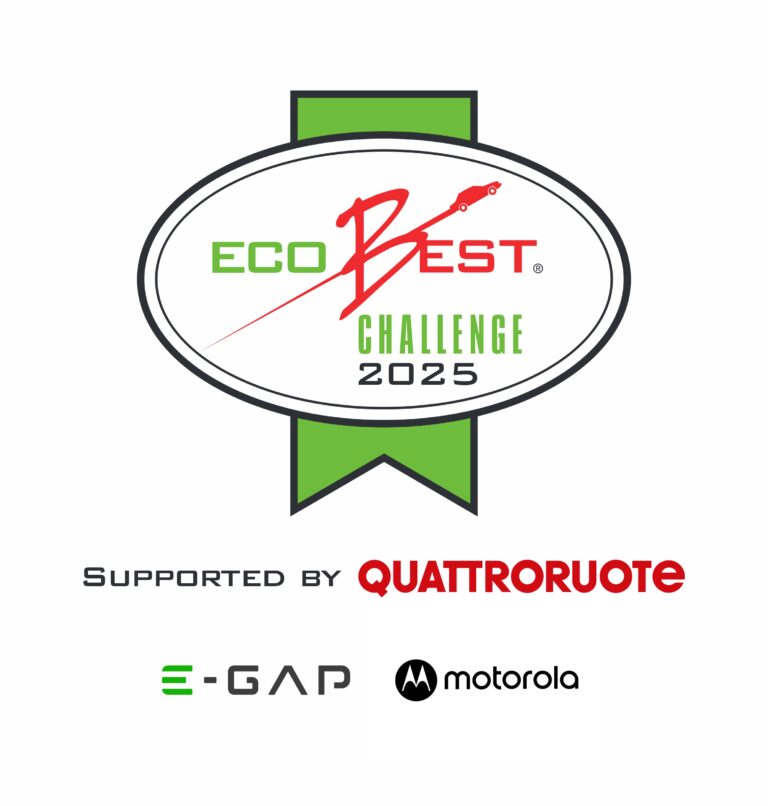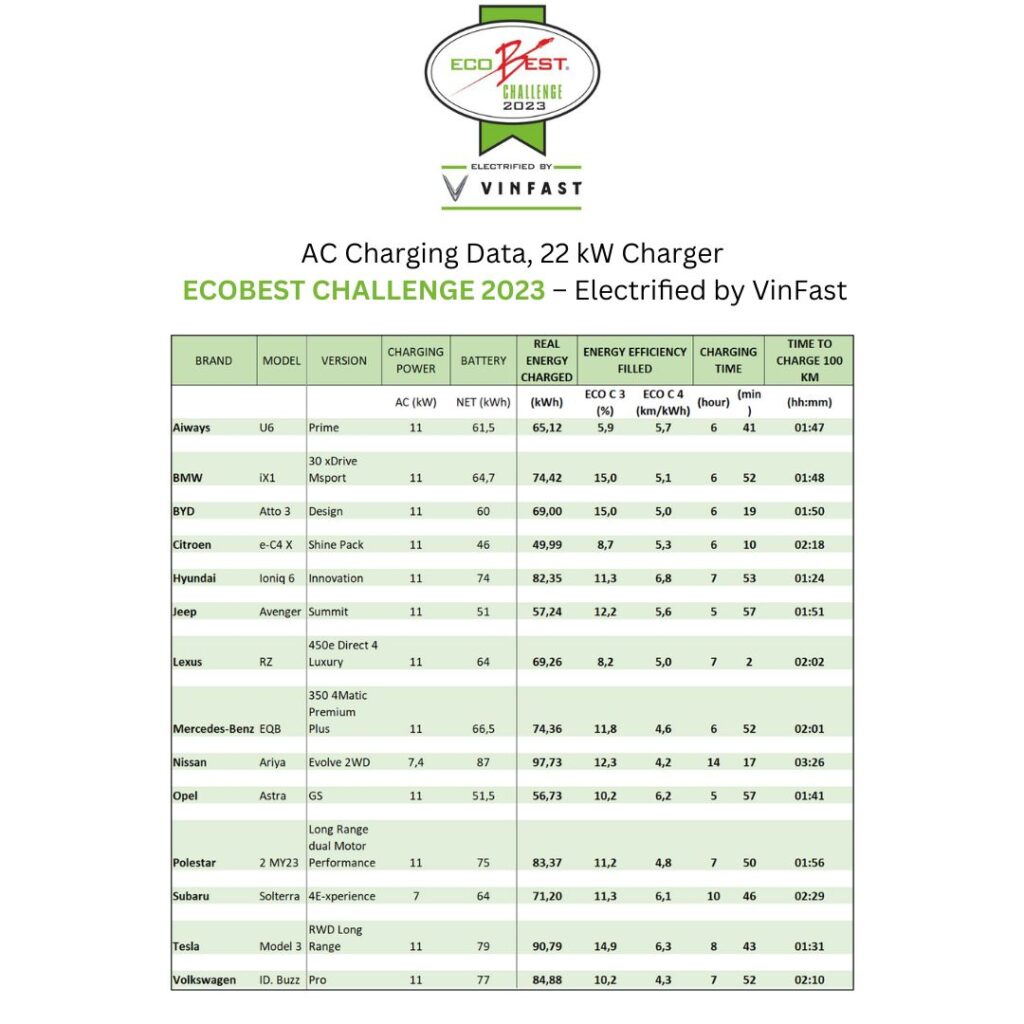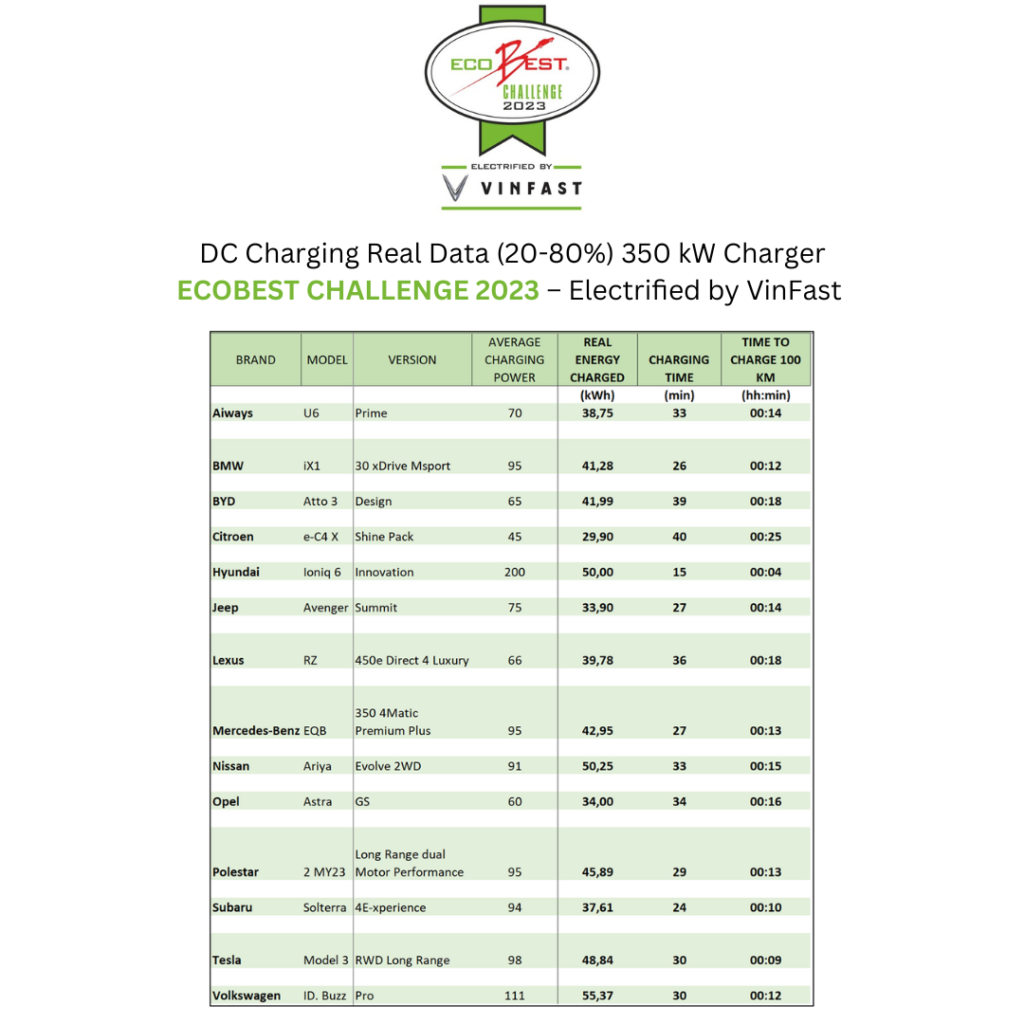

Preliminary considerations on the ECOBEST Challenge
The ‘ECOBEST Challenge 2023, electrified by VINFAST’ and supported by Quattroruote, is the first European independent real traffic test of mainstream EVs to reveal the real green credentials. It remains the only such test with a transparent, neutral and balanced approach. The results come from a consistent methodology of testing performed identically on all 14 cars. This methodology is inspired by the practical needs and driving behavior of most European motorists, coming from the habits in their daily commuting.
This edition the tested models are: Aiways U6, BMW iX1, BYD Atto 3, Citroen e-C4 X, Hyundai Ioniq 6, Jeep Avenger, Lexus RZ, Mercedes-Benz EQB, Nissan Ariya, Opel Astra, Polestar 2 MY23, Subaru Solterra, Tesla Model 3 and Volkswagen ID. Buzz. The detailed specs of each car tested is in the annex with all the measurements data’s.
It is not designed pro or con to any models or brands and is neither a typical motoring media comparative test nor a record-breaking range test or – by contrast – a rally speed test to check how agile EVs are. The ECOBEST Challenge states the results and does not comment on the differences between models in the test. The test results are available to European consumers as a basis for their decision-making process.
The 2023 edition received Bureau Veritas certification – a global recognition of the genuine, comprehensive, consistent and innovative methodology employed in testing electric vehicles (EVs) in real traffic conditions and assessing their real-life green credentials in an unbiased manner.
The key findings
As a consequence of this unbiased approach, the real range results show that WLTP is a bit more optimistic in comparison to driving in real traffic. None of the tested models did not achieve their homologated WLTP figure. However, all the cars reached more than 72.4% of the minimum WLTP reference used in all the indexes.
Only two years ago, AUTOBEST introduced a key index named EcoC 2, representing the quintessential idea of EV energy efficiency. In this reduced time frame, EcoC2 already achieved an important recognition among the EV consumers and the industry. It is simply how many kilometers of actual range one kWh of the battery can offer for a specific model.
“Compared with the previous edition, we discovered a better average EcoC 2 index for all the cars tested this year. The most efficient car managed 7,6 km/ kWh, a better result compared with last year’s record. Based on this evolution, we emphasize the need for all EV producers worldwide to continue the focus on how the energy is spent on the car’s propulsion. We stated already 2 years ago that entering in the new era of electromobility, we need to achieve 10 km/ kWh of battery in the next few years. It is an imperative mission of the entire industry to make the best use of onboard energy. “ stated Dan Vardie, Founder and Chairman of AUTOBEST and ECOBEST Challenge. The lowest EcoC 2 at the test was only 4,7 km/ kWh but better than the lowest of last year 4.5 km/ kWh.
The ECOBEST Challenge is one of the only independent tests in Europe measuring what happens after the battery reserve indicator/ available km reaches zero. All the cars have been driven to a total depletion of the battery when the cars stop entirely. AUTOBEST is happy to deliver good news to all motorists: except for one cars, there is still life in a battery once it indicates zero on the cluster. 13 cars proved between 2 and 45 kilometers of driving remained. The maximum `strategic reserve` measured this edition is representing an all -time record, an excellent news for someone in the extremely unpleasant to come to zero energy.
This year only one car ‘died’ immediately after the battery cluster indicated zero. Compared with last year, this year test shows a more diverse range with small and quite big figures, indicating an imperative need for consumers to inform themselves on this key information.
Although is very important to know how `much life you have in your dead battery`, AUTOBEST recommends keeping this as a strategic reserve of the battery and better never entering the situation to use it.
Another interesting result of the ECOBEST Challenge is the energy needed to fully charge cars with totally depleted batteries. All the vehicles required more energy than the capacity of the batteries, between 5,9% and 15%. The figures are in line with last year measurements, showing a kind of stagnation in reducing energy loss during the charging process.
The explanation for the additional consumption when recharging is studied and has several causes. Around 5% of energy is lost when transformed from AC (grid) to DC (battery). Some energy powers all the car systems used for charging, mainly the inverter but also the software, the socket, and everything related to the process. Energy is used to cool the battery during the process (this energy increases with fast charging, especially in hot climatic conditions). The state of the batteries and the charger type may also generate some losses.
In our continuous improvement, AUTOBEST has added the EcoC 4 index, an additional parameter for evaluating the true efficiency of electric cars. It measures how many kilometers the car runs on a single kWh considering not the nominal net capacity of the battery but the total amount of energy supplied by the charger to fill it. Above all the explanations we mentioned, the driver pays for energy, and these supplementary kWh ‘s are ‘escaping’ the trip computer.
Following the premiere of last year, we measured the AC and DC Fast Charging processes with great accuracy, using 22 kW AC stations and 350 kW DC stations which delivered to all the cars in test the maximum capacity to recharge. We also measured the time needed for the charging process.
“Here we are able to deliver probably the best news for the many millions of motorists still been reluctant for the time needed for fast charging. In DC we got a record of only 4 minutes to charge for 100 kilometers! This time is an outstanding achievement, showing that we are closer to the moment when the time for a full charge will be similar to the one filling the tank with conventional fuels. The record we just released today is giving us the opportunity to invite all stake holders in the electromobility, to invest in the most capable DC Super-Fast charging network everywhere in Europe as the best solution to address the range anxiety and the time needed for the charging process,” said Dan Vardie. The longest time encountered in the DC charging process was 25 minutes for 100 kilometers. Each car’s maximum charging capacity determines this time.
Two important notes: for the AC, we charged the batteries from 0 to 100%, and for DC, the charging process was 20% – 80%, the most common recommended cycle for such charging. The timings for charging 100 kilometers is an average of the entire charging process and has to be understood as such. As we noticed, charging rates are not linear during the DC fast-charging. AUTOBEST has all the charging graphs, which are a part of the data available on request.
Alessio Viola, the road test chief editor of Quattroruote, said: ” The EcoBest Challenge proves that progress is built step by step, even if is the fast growing EV sector. In this 2023 edition, for the first time we had two models that achieved a range of over 500 kilometers. Extremely interesting results, proving the ability of the key players to design efficient powertrains with top-level aerodynamics, which significantly contributes to improve efficiency. And then, the 800 Volt architecture, which guarantees extraordinarily fast recharging times and the satisfaction of buying a car that will remain up to date for a long time. We all know that the future of the electric car is not in bigger and bigger batteries, but in improving distances with every single kWh. And in faster and faster charging times.’
To get precise and complete data in the ECOBEST Challenge 2023, AUTOBEST, in close cooperation with Quattroruote and its Centro Prove, used Power checK Control (PKC) to analyze and certify an electric car. Since it is connected in real-time with the car via a Bluetooth Onboard Diagnostic II (OBDII) dongle, PKC accesses many parameters about the actual battery status: the SoC (State of Charge), the SoH (State of Health), the temperature, the car’s speed, weather conditions, the power used or regenerated by the car, the power during the charging phase and other relevant factors. EV drivers may get this expertise in daily life using Power Cruise Control. PCC suggests the right charging points along the route and precisely calculates how much kWh you need to charge. And to use it in the best way, this software gives constant feedback to the driver via an intuitive interface called the Heaven-Hell indicator.
Please see the Annex tables with all the relevant results to see all results.



How the ECOBEST Challenge electrified by VINFAST was organized
It took place in Vairano, where the proving ground of Quattroruote is based, near Milano. The professional motoring journalists of AUTOBEST drove 14 electric vehicles available in Europe (all with more than 350 kilometers of homologated WLTP range and a price list under €70,000 before taxes) to answer the most common question people ask when looking for an electric car.
The test started and finished at Vairano ASC, where we also recharged the cars. All the vehicles tested were regular production models with one person on board, climate system and infotainment equipment active and the tyre pressure recommended by the brand. All the cars were driven in ‘Normal’ mode and using Brake mode in the city environment when available.
Using a mixed trip, all the vehicles travelled a series of three circuits with different lengths with motorways (55%), conventional roads (25%) and urban environments (20%).
All the drivers changed cars every 30 kilometers to avoid any individual effect of the driving style in the results. All vehicles drove in convoy behind a leader, establishing the average speed and respecting the speed limits at all times.
After reaching the indication of 0% battery and/or 0 Km range appearing on the cluster, cars continued to run in the Vairano ASC until their complete stop.
For the third consecutive year, The ‘ECOBEST Challenge 2023’ was organised in partnership with VINFAST, the emerging Vietnamese manufacturer that will launch new EVs on the European markets in the end of this year and first half of next year. “I use this opportunity to thank the great support of VINFAST in organising our EV test. Although VINFAST has no cars in the test, the involvement is a part of its commitment to electromobility, giving the European consumer a fair chance to benefit from this process. These are values we share entirely at AUTOBEST,” added Dan Vardie.
AUTOBEST also thanks the leading title Quattroruote, widely considered the Italian car bible, for the full logistical and technical support.
The cooperation with Xiaomi and e-gap is also highly appreciated.
Disclaimer.
As the organiser of the ECOBEST Challenge, AUTOBEST stands behind all the results and figures resulting from an unbiased test conducted precisely in the same manner for all the cars- as certified by Bureau Veritas. AUTOBEST is confident that all the results are much closer to reality than the WLTP homologated figures. Therefore, AUTOBEST is inviting all European motorists to use all the info provided to decide based on their needs. The aim of the ECOBEST Challenge is not to rank the 14 cars but to offer an average reference that can lead to a more realistic option for each and every European consumer. There are no worse or good vehicles and ranges. Everyone should make a personal choice based on the individual mobility needs. AUTOBEST believes there is no car able to satisfy all the consumers’ possible needs. The ECOBEST Challenge provides an average obtained under certain conditions of landscape, temperature, cycle of testing etc. Although we believe we are very close to the ideal average, AUTOBEST is not claiming this.
For more info please visit www.autobest.org
Download here the press release:
Or send your enquires to events@autobest.org
In 2009 AUTOBEST launched ECOBEST Challenge project, as a world’s first project for measurements of consumption, CO2 emissions, pollutants and micro particles. ECOBEST Challenge was launched years before Diesel gate scandal, with the aim to give consumer real data in real life traffic.